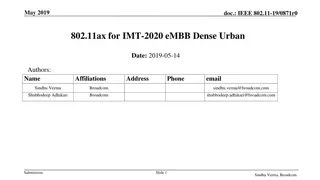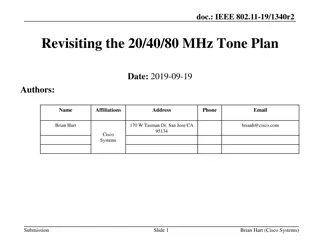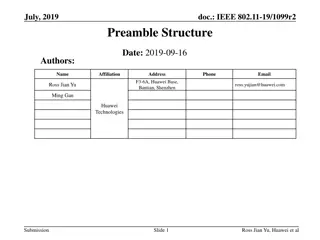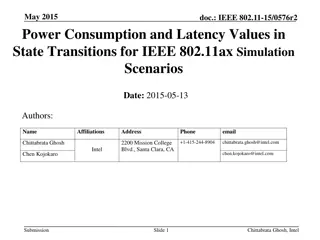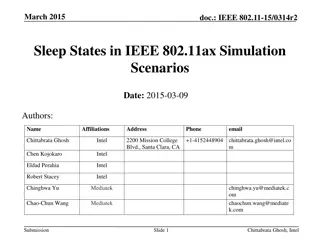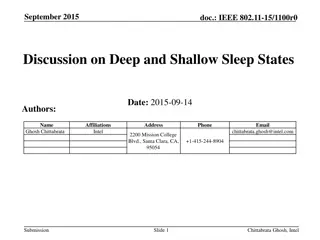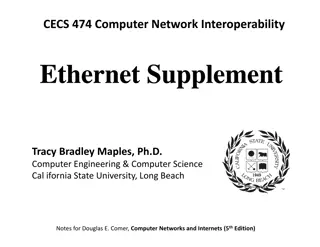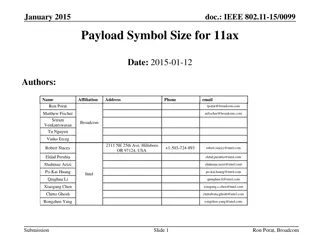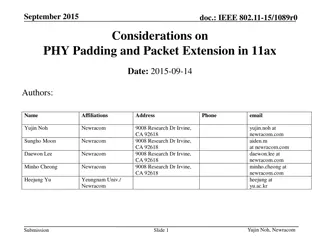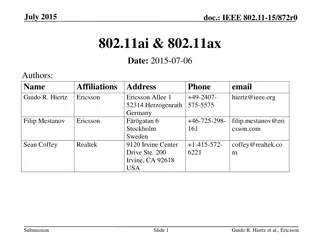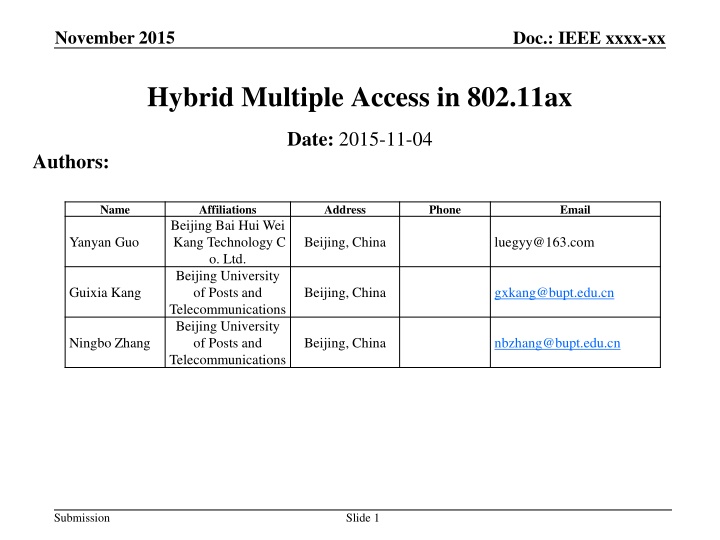
Hybrid Multiple Access in 802.11ax Networks
Explore the implementation of Hybrid Multiple Access in 802.11ax networks to address resource collision issues arising from massive connections in the Internet of Things (IoT). Discusses the use of NOMA and OMA schemes for improved spectral efficiency and access capacity, along with performance evaluations and access mode selection in this context.
Uploaded on | 0 Views
Download Presentation

Please find below an Image/Link to download the presentation.
The content on the website is provided AS IS for your information and personal use only. It may not be sold, licensed, or shared on other websites without obtaining consent from the author. If you encounter any issues during the download, it is possible that the publisher has removed the file from their server.
You are allowed to download the files provided on this website for personal or commercial use, subject to the condition that they are used lawfully. All files are the property of their respective owners.
The content on the website is provided AS IS for your information and personal use only. It may not be sold, licensed, or shared on other websites without obtaining consent from the author.
E N D
Presentation Transcript
November 2015 Doc.: IEEE xxxx-xx Hybrid Multiple Access in 802.11ax Date: 2015-11-04 Authors: Name Affiliations Beijing Bai Hui Wei Kang Technology C o. Ltd. Beijing University of Posts and Telecommunications Beijing University of Posts and Telecommunications Address Phone Email Yanyan Guo Beijing, China luegyy@163.com Guixia Kang Beijing, China gxkang@bupt.edu.cn Ningbo Zhang Beijing, China nbzhang@bupt.edu.cn Submission Slide 1
November 2015 Doc.: IEEE xxxx-xx Background Internet of Things (IoT) is an important scenario in the future Hundreds of billions of M2M UEs will access the network. Massive connections require 802.11ax to improve the capacity of access Massive connections result in serious resource collision issue Orthogonal multiple access (OMA) random access (RA) is traditional RA in 802.11 and LTE systems NOMA with successive interference cancellation (SIC) is a positional technique to improve the spectral efficiency as well as the number of accesses Submission Slide 2
November 2015 Doc.: IEEE xxxx-xx Current CSMA scheme in 802.11ac DIFS Frozen DIFS Backoff Backoff RTS STA1 Busy CTS_timeout DIFS Backoff RTS STA2 CTS_timeout DIFS Backoff RTS STA3 CSMA (OMA scheme) Only one STA is allowed to transmit message in a channel When detecting the resource is occupied, it regards the detection as a collision and reattempts random access after a back-off. Submission Slide 3
November 2015 Doc.: IEEE xxxx-xx Performance of NOMA 0 (MMSE-SIC) receiver is performed at AP 10 OMA Access 1st UE in NOMA group A 2nd UE in NOMA group A 1st UE in NOMA group B 2nd UE in NOMA group B 3rd UE in NOMA group B -1 10 The performance of NOMA degrades compared to OMA There exists SNR threshold between the OMA RA and the NOMA RA for a target BLER. Taking as the target BLER, the SNR threshold is about 6.3dB BLER NOMA group B OMA mode NOMA group A -2 10 6.3dB 1.1dB 11.4dB -3 10 -4 -2 0 2 4 6 8 10 12 14 2 10 Reference SNR(dB) Transport block size (TBS) :100 bits Modulation order: QPSK The number of STAs in Group A: Two The number of STAs in Group B: Three Channel model: Extended pedestrian A (EPA) Difference of received power : 5dB Submission Slide 4
November 2015 Doc.: IEEE xxxx-xx Hybrid RA in 802.11ax Access mode selection Received SNR at AP Access Mode selection NOMA OMA Group center STA STA AP STA AP P Step 1: Peer discovery Step1: channel detection r = SNR Step 2: NOMA group establishment 2 r Step 2: detection response Step 3: Channel detection Step 4: Detection response 2 where is the variance of noise and is the received power at AP. Step 3: Message transmission or back-off Step 5: Power Back-off rP Step 6: SIC reception and ACK Fig.2 Hybrid RA scheme = , M P min 10log P P PL u r u max 10 Submission Slide 5
November 2015 Doc.: IEEE xxxx-xx NOMA RA Step 1: Peer discovery: This step is to discover neighbor paired STAs. Step 2: NOMA group establishment: Select a group center and allocate the power back-off index. Step 3: Channel detection: The group center sends preamble to detect the channel on behalf of NOMA group. Step 4: Detection response: AP sends back the detection response to NOMA group STAs. Step 5: Power back-off: NOMA group STA power back-off to guarantee diverse received power at AP. Step6: SIC reception and ACK: AP performs SIC receiver to cancel multi-STA interferences and sends back ACK/NACK. Submission Slide 6
P 2 10 max November 2015 Doc.: IEEE xxxx-xx Simulation results Simulation assumptions 250 OMA RA, theoretical Hybrid RA, theoretical with Pf = 0 OMA RA, simulation Hybrid RA, simulation with Pf = 0 Number of successful accesses Parameters Radius of AP Carrier frequency Bandwidth Value 500m 2GHz 20MHz 23dBm 1 200 150 Fading channel model Extended Pedestrian A 100 TBS 100bits QPSK Modulation order Target BLER Receiver at eNB 50 MMSE-SIC 0 0.05 0.1 0.15 0.2 0.25 0.3 0.35 0.4 0.45 0.5 Observations Hybrid RA scheme increases the total number of accesses by 55.7% compared to OMA RA scheme. Distance between UE and eNB(Unit: km) Fig.3 The number of accesses for OMA RA and hybrid RA Submission Slide 7
November 2015 Doc.: IEEE xxxx-xx Summary Hybrid RA significantly improve the number of accesses STA adaptively selects the OMA RA procedure or the NOMA RA according to a predefined SNR threshold. AP performs SIC receiver to cancel multi-STA interferences. Clearly, adaptive OMA RA and NOMA scheme achieves larger number of accesses than OMA RA scheme. Next step Work out an practical SNR threshold set for OMA RA and NOMA selection. Calibrate the WLAN system level simulation with hybrid RA scheme for a number of simulation scenarios. Submission Slide 8
November 2015 Doc.: IEEE xxxx-xx References [1] IEEE 802.11ac-2013, Part 11: Wireless LAN Medium Access Control (MAC) and Physical Layer (PHY) Specifications--Amendment 4: Enhancements for Very High Throughput for Operation in Bands below 6 GHz, 2013. [2] IEEE 802.11ad-2012, Part 11: Wireless LAN Medium Access Control (MAC) and Physical Layer (PHY) Specifications Amendment 3: Enhancements for Very High Throughput in the 60 GHz Band, 2012. Submission Slide 9
November 2015 Doc.: IEEE xxxx-xx Thanks! Submission Slide 10


